There’s never been a better time to buy a classic Mercedes-Benz convertible, and with the 30th anniversary of the R129 SL, many might. We say why you should – and show you the alternatives.
While spring hasn’t quite sprung yet, it’s only just around the corner. And what better way to welcome the weather than by going topless? As the weather improves, convertible classics will become coveted – especially those from prestige brands such as Mercedes-Benz. That makes the dying embers of winter a perfect time to buy a premium classic cabrio – and in the thirtieth anniversary year of the R129 SL, it makes a clear and compelling classic choice. But what if you want the three-pointed star, but the R129 doesn’t meet your needs? We’ve gathered together six of the best classic Mercedes convertibles of the last sixty years, in order to celebrate all that’s great about sunseeking Stuttgart-style.
THE SL DYNASTY
R129
Launched in 1989, the R129 SL had a tough act to follow. Its predecessor had been on sale for the best part of two decades, and had been adored the world over as a symbol of wealth, good taste and sense. The new car had to retain all these virtues, while bringing the SL brand kicking and screaming into the 1990s. Later models featured more toys, and in the smaller-engined models better weight distribution courtesy of a V6 – but the ones we like best at Classic Car Buyer are pure original examples like the original 12-valve 300SL.
Despite the fact that – if anything – the ride is even better than its predecessor, the R129 was a more sporting SL than before. It feels less like a two-door saloon with the roof cut off, despite the fact that under its svelte body lies the cut-down platform, essentially, of a W124 300E. Perhaps this shows how far forward saloon car technology had developed in two decades? Regardless, it ensures that the R129 still feels as fresh in 2019 as it did thirty years ago.
Through its fourteen year life the R129 was available with 12- and 24-valve straight sixes of 2.8-, 3.0- and 3.2-litres, a pair of 2.8-litre and 3.2-litre V6s, a couple of powerful V8s and even Mercedes’ glittering V12 in the SL600. Most collectable today is the rare SL60 AMG; with its enlarged V8 this was capable of 0-60 in just 5.6 seconds.
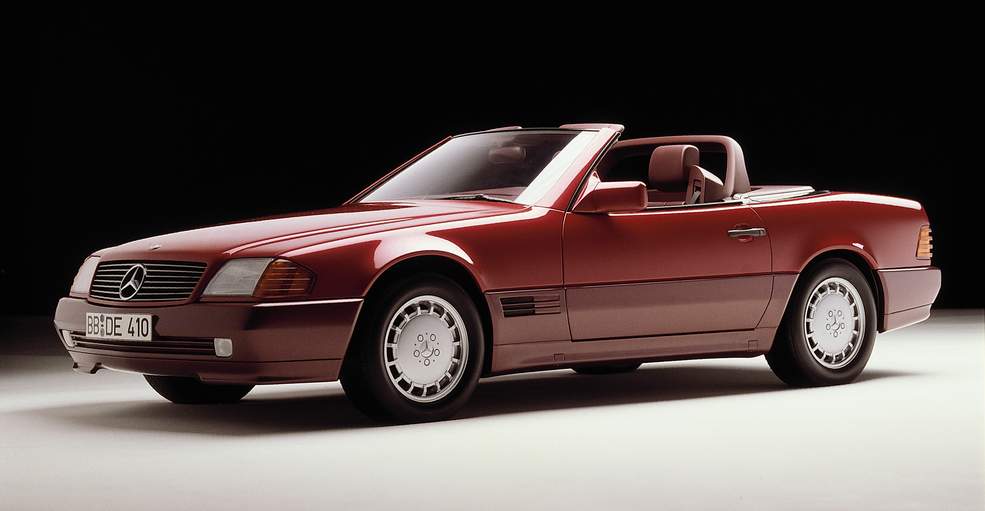
SL60 values, needless to say, outstrip standard models by a considerable margin! R129 values in general are firming up after years seen as the ‘cheap one’, as R107 values rose to meet ‘Pagoda’ prices, the R129 has become the car for investors to buy now and save for later. As demand becomes greater, inevitably values will rise further.
From behind the wheel, you can see how late R107 buyers might have felt a little short-changed had they the chance to experience an R129 before their purchase. There are clear hints of the W140 S Class in here, most notably the offset centre vents, complete with miniature stowage box atop them. Yet while the chassis architecture is W124 derived, it doesn’t share the 300E’s nose-heaviness. This is a far better balanced car than the saloon upon which it’s based, and leagues ahead of the R107 in agility. Its wider track means that it can corner flatter, while retaining the smoothness of the older car over bumps. The steering feels slightly sharper too – not to the point of becoming sporting, but just enough to feel as if progress has been made over the earlier car. It’s a smooth operator…

R107
Mercedes had set the bar high when it came to replacing its iconic Pagoda SL, and the R107 was the result of several years’ careful development. The Pagoda had become the darling of the smart set; at home in Chelsea or Monaco and owned by such celebrities as Audrey Hepburn and Sophia Loren. And while it had been launched in 1963 as a sports car, the larger engines and automatic gearboxes of later models meant the SL had become a GT by the time of the 280 in 1967. The R107 would build on this; launched with a 3.5-litre V8 as its sole option, it was a concerted move upmarket for the drophead Benz. Soft, yielding suspension, plenty of lean in the corners, a quiet engine and an automatic gearbox leave you in no doubt that this is a GT, not a sports car – it may look dynamic, but in truth it’s little different to the contemporary saloons underneath. The R107’s twenty year life saw myriad versions, ranging from a 2.8-litre straight six (later 3.0), through the all-iron 3.5-litre and 4.5-litre V8s of the 1970s, to a pair of all-alloy replacements with the 380 and 500SL models. The Americans, damned by emissions gear and facing distinctly dulled performance, even got a 5.6 litre variant using the engine from the W126.
To drive, this is how a convertible ought to be in the 21st century. With ever-worsening road surfaces, we don’t want firm suspension and big wheels. Long-travel springs, nice damping and light steering are far more desirable traits – more civilised, more relaxed. And it feels special, in a timeless way despite the very ’70s colour schemes that so many were specified in. The soft seats support you in the way that only old Merc seats can, everything is to hand, and while some of the soft touch plastics are alien to those used to modern finishes, they’re just what an old Mercedes should have. The R107 might be forty eight years old in design, but it feels more relevant today than it ever did. Prices have firmed up considerably over the last five years or so. Back then £10,000 might have secured one of the nicest examples in regular use; today a car like that might command nearer to £20,000-25,000. And as Pagoda values continue to rise, R107 values will expand to fill the gap.
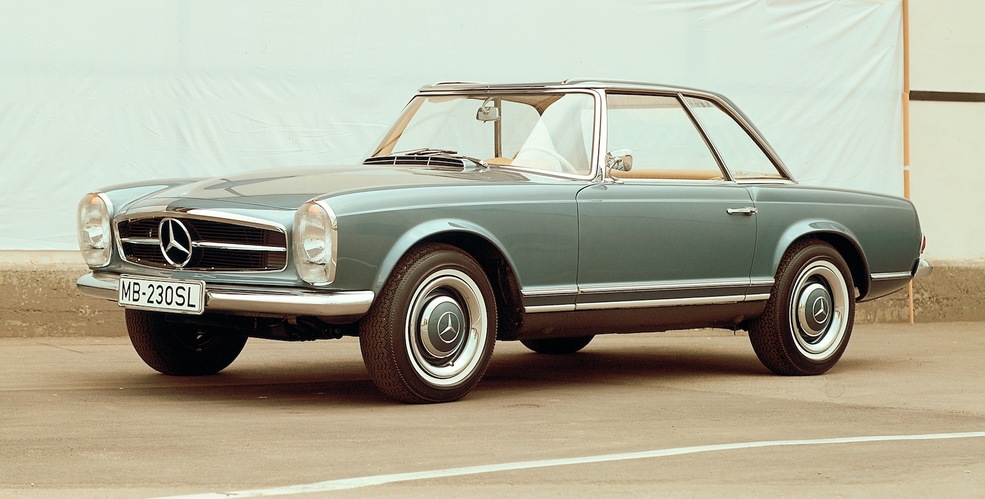
W113 ‘Pagoda’
Think of 1960s celebrities and eventually the topic will turn to the Mercedes SL. Everybody who was anybody had one – Audrey Hepburn, Sophia Loren, Peter Ustinov and Sir Stirling Moss have all owned and enjoyed the sporting drophead. Even today, it’s enjoyed by the rich and famous. Ryan Giggs, Kate Moss, Nico Rosberg, John Travolta and Harry Styles all own W113 Mercs. Over the course of the Pagoda’s run, Mercedes tweaked the formula, pulling it further from the original lightweight sports concept and further toward becoming a GT car.
A good W113 today is a rarefied possession available only to the fortunate few. Really nice examples can command upwards of £100,000, with the late 280s being the most valuable models. 250s are less valuable, and the original 230 less valuable still, with £85000 buying one of the nicest 230s on the market despite its more sporting bent. £40000-70000 will get you a reasonable example from a private seller if you’re prepared to look hard enough. Manuals – especially the rare five speed ZF – are worth more than automatics owing to their rarity, and original cars are worth more than restored examples unless the restoration is especially good.
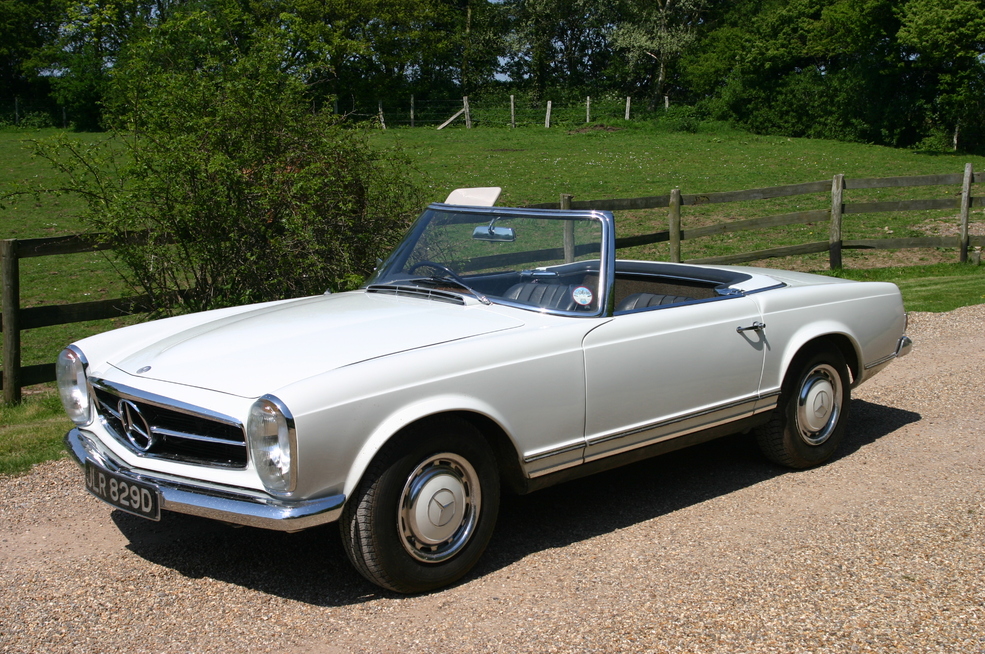
Paul Bracq was responsible for much of the styling, but the hardtop roof – the item which led to it becoming dubbed the Pagoda – was the work of Béla Barényi. Barényi was also responsible for some intelligent aspects of the car’s design. It was the first sports car to be designed with safety in mind, featuring front and rear crumplezones. At launch, Mercedes’ chief engineer performed an impressive stunt to demonstrate the capabilities of the new SL. Grand Prix driver Mike Parks had previously lapped the three-quarter mile Vétraz-Monthoux racing circuit in Annemasse in 47.3 seconds, in a Ferrari 250GT. Engineer Rudolf Uhlenhaut achieved a time of 47.5 seconds in a brand new 230SL, despite a deficit of almost 100BHP and 6 cylinders and despite not being a professional racing driver. While the SL may not have been a sports car, it was certainly sporting enough for most.
In 1966 Mercedes updated the concept with the more powerful 250SL, which brought rear disc brakes and increased power to the SL range. In the following year, Mercedes launched its final W113 derivative, the 280SL. Power was once again increased, though the whole car was softened to reflect its new status as a GT rather than a sports car. This final evolution was the strongest-selling W113, with the majority of production heading to America with automatic transmission. Mercedes, aware of the direction the market for prestigious convertibles was heading, developed the replacement R107 SL with a focus on touring ability rather than sporting prowess. Its launch in 1971 as the 350SL marked the end of W113 production, and the end of one of the most special eras in the SL model’s lifetime.
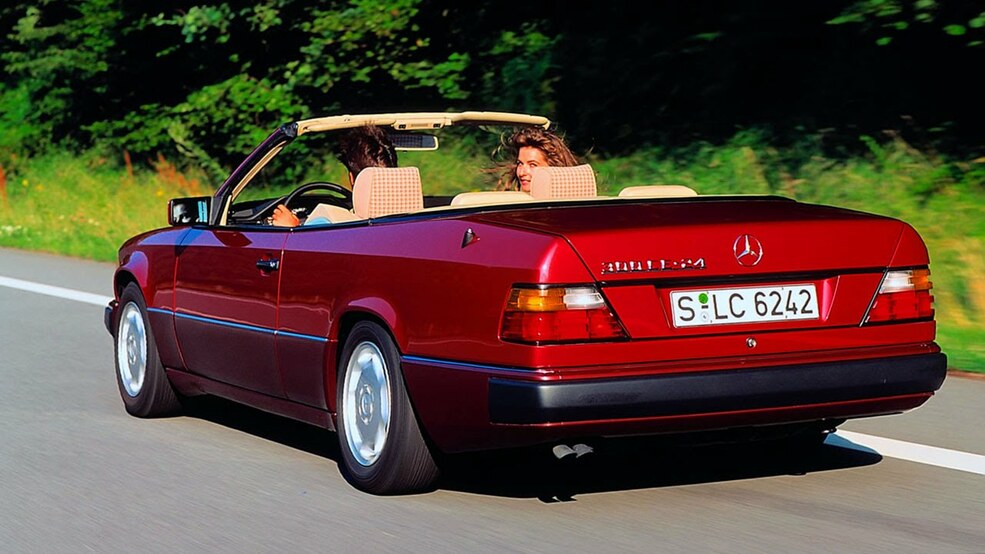
FOUR SEAT FUN
W124 Convertible
Following the death of the W111 range, Mercedes allowed its two-seat SL to become the range topping convertible. Meanwhile, future S Class coupes were to become available as fixed-head only – and then only after a seven year hiatus. For most of the 1970s and all of the 1980s, a four-seat Mercedes-Benz convertible was something only available if you were prepared to pay the converters – such as Crayford, whose W123 St Tropez conversion showed Mercedes how strong the market could be. In 1991 Mercedes supplanted its popular W124 CE coupe range with the 220bhp 300CE-24 convertible. Supplanted in 1992 by the 217bhp 320CE, rebranded E320 and supplemented by the 150bhp E220 convertible in 1993, the range is prized by Mercedes enthusiasts and open-air motorists alike as one of the last true four-seat open tourers. Mercedes also produced a limited run of E36 AMG convertibles, if you want to feel the wind tear your hair out. A full four-seater, the W124 convertible wasn’t a cheap car when new, commanding similar prices to the Jaguar XJS. That didn’t hinder sales though; it enjoyed healthy sales figures until its death in 1997 – two years after the saloon and estate versions were discontinued.
W208 CLK
The cheapest way into drop-top Merc motoring is still the CLK. Launched in 1997 as a replacement for the W124 E Class Coupe and Cabriolet, the CLK shared the styling of the contemporary W210 E Class but was in fact based on the floorpan and underpinnings of the smaller W202 C Class. This meant pricing could be more aggressive, and the new model name allowed Mercedes to target the car to a slightly more dynamic, younger audience than before. Unlike its predecessor, the CLK was intended to compete with the smaller BMW 3-Series Coupe and Cabriolet, and its 134bhp CLK200 and 194bhp CLK230K launch specifications were ideally suited to competing with the 320i and 328i. If four cylinders aren’t enough, the CLK was subsequently available with a 3.2-litre V6, a 4.3-litre V8, and the startling 5.5-litre V8 from the E55 AMG. Our picks of the range would be the supercharged CLK230 Kompressor and the V6 CLK320 – both offer more than enough go without denting your wallet too badly. A CLK430 could be an excellent buy, however, if you crave the performance and are prepared to seek out a good example. Beware though that pricier servicing bills may mean one or two have been missed over the years.
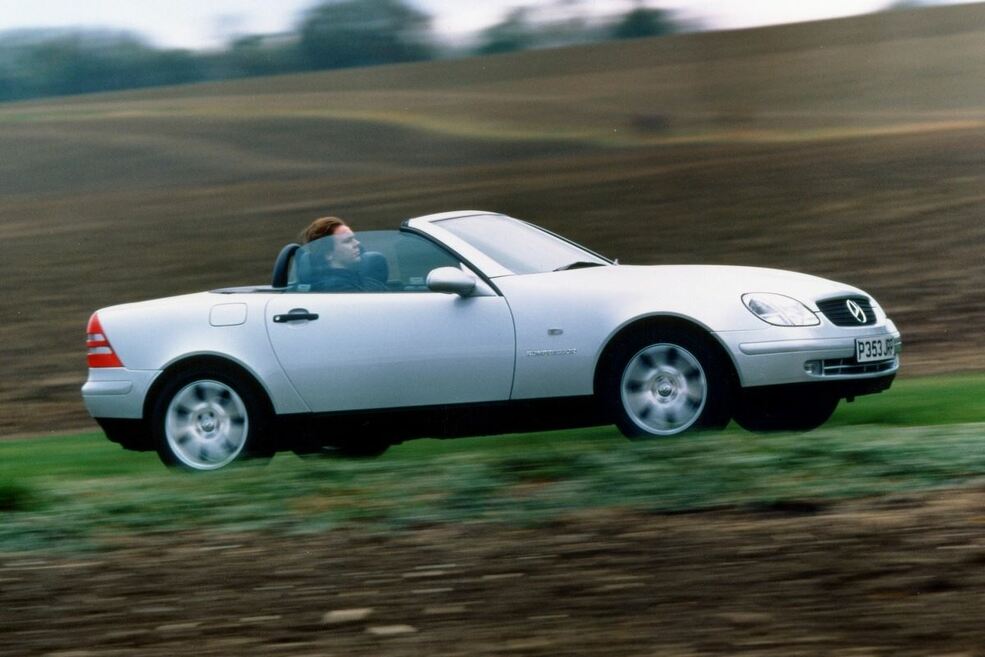
SPORTING GEM
R170 SLK
Previewed in 1994 as the SLK-II concept car, the SLK was a response to cars such as the Mazda MX-5, and competed alongside BMW’s Z3 and Porsche’s Boxster in the premium drophead market. Conceptually, it evoked the 190SL; a sensible sportscar for the people who had been left behind as the SL range became ever-larger and softer in aim. If you prefer B roads to boulevards, the SLK could well be the ultimate drophead Merc. And as with Mercedes’ previous small sportscar, it was based on the underpinnings of the marque’s smallest saloon – which at the time of development was the humble 190. It received the newer 16 valve engines developed for the C-class – originally there was to be a four cylinder and a six cylinder at launch, but the 2.8 litre six proved to be too heavy for the SLK. Amid fears of nose-heaviness and poor handling, Mercedes instead chose to rework its M111 2.3-litre four-cylinder with a supercharger, in order to achieve an identical 193bhp. As if that wasn’t enough, the SLK was a small roadster with a folding hard roof – a design feature which had rarely been seen before, most notably in America in the Ford Fairlane Skyliner. The SLK prompted a trend among small convertibles for folding hard roofs, notably those manufactured by Peugeot, and redefined the small sportscar genre. Later models included the SLK320 V6 and the supercharged SLK32 AMG.
CONCLUSION
Whatever your budget, there’s a convertible Mercedes to suit. The SLK and CLK offer fantastic value for money right now, while the timeless beauty of the W124 cabriolet means that it is rightly appreciating by the day. The SL family has become iconic among certain strata of society – and whether you have £10,000 or £100,000 to spend, there’s an SL that will suit your pocket. Many regard the R129 SL as the last proper Mercedes. Is it? We wouldn’t like to comment. But now is certainly the time to buy before values rise to the level of the R107 and the Pagoda which came before.





